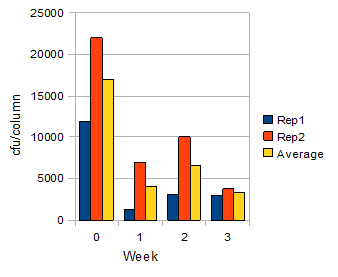Sand column spore trap
for quantifying aerial inoculum of Phytophthora ramorum and aerial Phytophthora species
If you build a better spore trap...
We really were not looking for people to beat a path to our door, which already has a pretty good path leading to it. However, for some of research we have been doing on sudden oak death, caused by Phytophthora ramorum, we needed a better method for detecting and quantifying Phytophthora spores in rainfall (more precisely, canopy throughfall - water dripping through tree canopies).
There are already several ways to address this issue. Direct capture of rainfall, followed by filtration and plating can provide quantitative information about inoculum levels, but the methodology is very labor intensive. In particular, rainfall needs to be collected and processed as soon as possible after a rain event. This is difficult if there are many rainfall collectors scattered among multiple locations.
We have previously used the leaf baiting method (floating California bay leaves are left in open buckets of water for up to several weeks). The buckets and water need to be carried in to the trap locations, which can be relatively labor intensive for many widely-scattered sites. in our experience, this method is not particularly sensitive. It is also susceptible to artifacts associated with inoculum cycling within the water or degradation of the bay leaves. This method has been described as "semi-quantitative" and may be under some situations. However, we believe that in many situations, it provides only presence/absence sampling information.
We have also used soil sampling (collecting and baiting soil samples), which is somewhat less labor intensive than the foregoing methods. However, it is relatively insensitive and is only likely to detect relatively high inoculum levels. The efficiency of soil baiting may also vary with soil properties, which presents difficulties when making comparisons between plots. This method is also strictly qualitative, providing only presence/absence data for each sample.
Our goal in developing a sand-based trap was to find a method for measuring inoculum production within plots that:
- is not overly labor intensive,
- is relatively insensitive to sources of interference and variation that affect the soil and California bay leaf bait methods, and
-has the potential to provide quantitative data on inoculum levels in treated vs. untreated plots.
The method builds on the soil baiting method, taking advantage of the fact that P. ramorum is relatively long-lived in soils and potting mix. It was also inspired in part by the use of sand columns to remove Phytophthora propagules from contaminated water sources.
We conducted a number of lab experiments to obtain proof of concept for the method and to optimize the design of the trap. Without going into all these results, suffice it to say that we could detect P. ramorum with the trap by both baiting (using rhododenron leaf disks) and direct plating of the sand media on PARPH. We also determined that baiting was more sensitive than plating (i.e., will detect lower amounts on inoculum in the sand). Also, for columns that were infested with lab-produced zoospore suspensions, propagule detection dropped substantially between time 0 (immediately after applying the suspension) and one week later. However, recovery of propagules from columns sampled 1, 2, or 3 weeks after adding inoculum did not change significantly (see graph). Columns were maintained in a growth chamber (20 C day / 10 C night). This was what we were looking for, as we knew that we were gerneally not going to be picking up columns in the field for a week or more after the last rain event. We also knew that we could run a lot of lab expeiments that might or might not really tell us how the columns were going to perform under field conditions. Field conditions are much more variable than lab conditions. Furthermore, field conditions may differ from lab tests with respect to types and numbers of propagules present, precipitation rates, the timing of inoculum shower events, and many other variables. While additonal lab test may still be warranted to work out various details of how the system funcitons, we have proceeded to employ these traps in the field to get more information on their performance under real-work conditions.
|
Average number of P. ramorum propagules detected per spore trap column via soil plating at different dates after input of zoospore suspensions. Rep 1 and rep 2 represent the two different columns harvested at each date. Yellow bars represent the average of both columns. |
